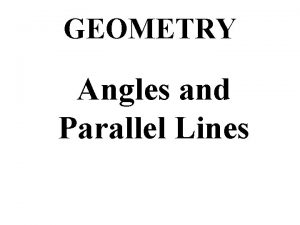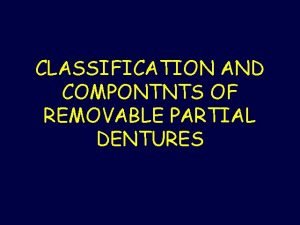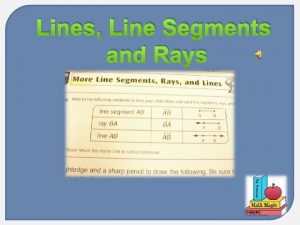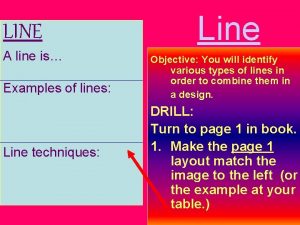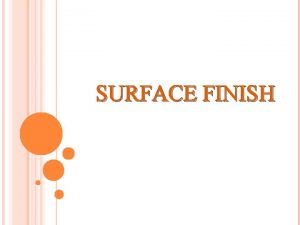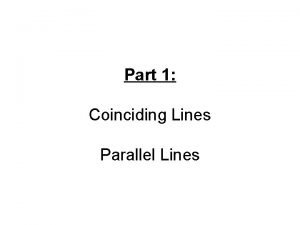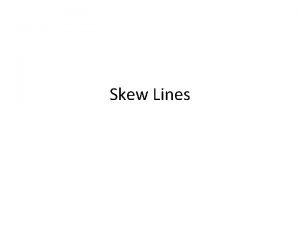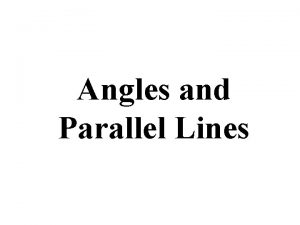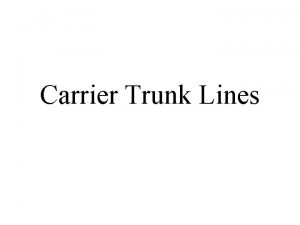FINISH LINES A FINISH LINE is the planned















- Slides: 15

FINISH LINES

A FINISH LINE is the planned junction of different materials. The FINISH LINE of an RPD is the junction of the plastic denture base with the metal of the framework.

FUNCTIONS n n n 1. A finish line creates a definite limit to the plastic of the denture base. In this way the plastic ends in a bulk of material. Thin areas of plastic are weak, flexible, and subject to fracture. 2. Undercut finish lines provide mechanical retention for the plastic denture base. 3. Finish lines provide a smooth transition from the plastic base to the RPD metal framework.

Prosthetic Tooth Undercuts Plastic Denture Base

INTERNAL AND EXTERNAL FINISH LINES The INTERNAL FINISH LINE is located on the tissue surface of the RPD. It is formed during the block out and relief step of constructing the framework

The EXTERNAL FINISH LINE is located on the polished surface of the RPD. It is formed during the wax-up of the pattern for the framework on the refractory cast. The internal and external finish lines are staggered by 1 -2 mm so that the metal will not be thin and weakened.

LOCATION OF FINISH LINES Internal finish lines should be located such that relining the tissue surfaces of the base will compensate for edentulous ridge resorption. External finish lines should be located such that the polished surface of the base compensates for the missing alveolus while not interfering with tongue movements during function.

FINISH LINE DESIGNS The finish line design varies with the type of denture base (tooth supported or toothtissue supported) and whether the RPD is mandibular or maxillary.

MANDIBULAR TOOTH-TISSUE supported finish line The mandibular tooth-tissue supported finish line is the most frequently used design. With this design the external finish line begins at the occlusal (incisal) of the proximal minor connector and angles away from the tooth about 15 degrees. It terminates at the inferior border of the major connector. The internal finish line parallels the external and ends 2 -3 mm superior to the inferior border of the major connector.


MANDIBULAR TOOTH SUPPORTED FINISH LINE The external finish line of a mandibular tooth supported base begins at the occlusal (incisal) of the proximal minor connector, passes cervically parallel to the long axis of the tooth to a point 4 -5 mm inferior to the ridge crest where it turns and passes parallel to the ridge to join the finish line of the other abutment tooth. The internal finish line parallels the external finish line and is 1 -2 mm superior to it (closer to crest of the residual ridge).

MAXILLARY TOOTH SUPPORTED FINISH LINE The maxillary tooth supported finish lines are similar to the mandibular tooth supported finish lines. When viewed from the occlusal the maxillary tooth supported finish lines will be at least 2 mm more medial to a line connecting the lingual surfaces of the abutment teeth.

MAXILLARY TOOTH-TISSUE SUPPORTED FINISH LINE Design I the external finish line begins at the occlusal (incisal) of the proximal minor connector, passes cervically parallel to the long axis of the tooth to a point 4 -5 mm superior to the ridge crest where it turns and passes parallel to the ridge to its termination at the posterior edge of the major connector in the hamular notch-vibrating line area. The internal finish line parallels the external finish line and is 12 mm closer to the ridge crest. The internal finish line terminates 2 -3 mm short of the posterior edge of the major connector allowing ease of adjustability. n


Design II In Design II the external finish line begins at the occlusal (incisal) of the proximal minor connector, passes cervically parallel to the long axis of the tooth to a point 4 -5 mm inferior to the ridge crest where it turns and traverses the palate at a right angle to the midpalatal suture, eventually joining the external finish line on the opposite side of the arch. The external finish line may cross the palate distal to the abutment teeth to move the metal-plastic junction further to the posterior where it will be less noticeable to the tongue. The internal finish line parallels the external finish line and is 1 -2 mm further distally. n
 Planned economy or planned destruction political cartoon
Planned economy or planned destruction political cartoon Line vw and line xy are parallel lines
Line vw and line xy are parallel lines Common vertex
Common vertex Principle of surveying
Principle of surveying Horizontal finishing line
Horizontal finishing line Precision attachment parts
Precision attachment parts In the race of excellence there is no finish line
In the race of excellence there is no finish line Hát kết hợp bộ gõ cơ thể
Hát kết hợp bộ gõ cơ thể Frameset trong html5
Frameset trong html5 Bổ thể
Bổ thể Tỉ lệ cơ thể trẻ em
Tỉ lệ cơ thể trẻ em Voi kéo gỗ như thế nào
Voi kéo gỗ như thế nào Chụp tư thế worms-breton
Chụp tư thế worms-breton Hát lên người ơi alleluia
Hát lên người ơi alleluia Môn thể thao bắt đầu bằng từ chạy
Môn thể thao bắt đầu bằng từ chạy Thế nào là hệ số cao nhất
Thế nào là hệ số cao nhất


